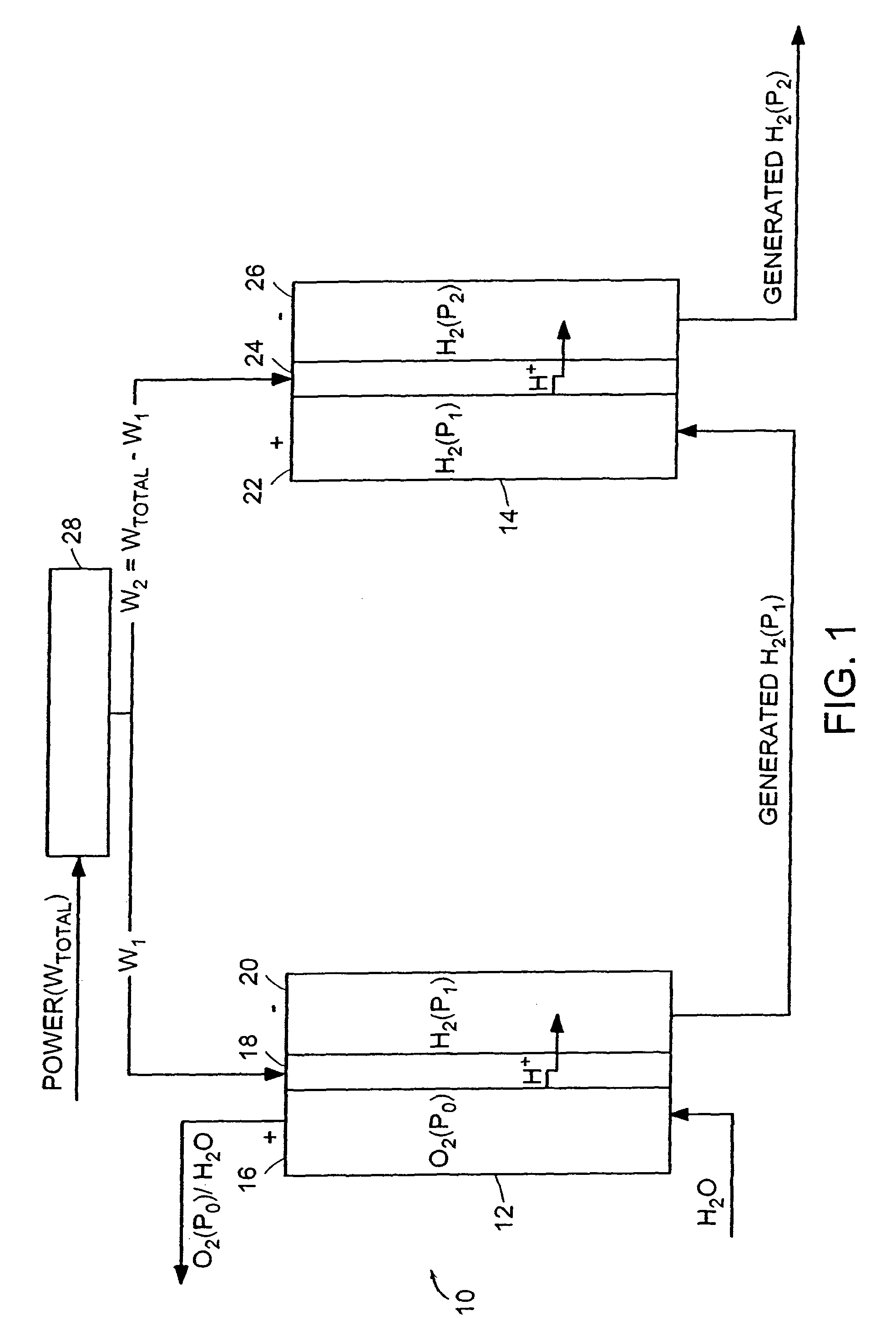Method and system for producing high-pressure hydrogen
a high-pressure hydrogen and hydrogen technology, applied in hydrogen/synthetic gas production, specific gas purification/separation, inorganic chemistry, etc., can solve the problems of difficult support of mea, mechanical properties of membrane, rapid degradation of metallic support structures and compression pads, etc., to reduce faradaic efficiency, reduce current density, and reduce voltage efficiency loss
- Summary
- Abstract
- Description
- Claims
- Application Information
AI Technical Summary
Benefits of technology
Problems solved by technology
Method used
Image
Examples
example 1
[0046]A hydrogen compressor cell 30 with active cell area of 0.05 ft2 was assembled with a 5-mil (dry) membrane 102 (Dow Chemical, Midland, Mich., Dow XUS 13204), having an equivalent weight of approximately 800 and an ion-exchange capacity (meq of H+ ion / g of dry polymer) of 1.25. Pt black electrode structures 104, 106 were integrally bonded to each surface of the membrane 102. Ambient-pressure hydrogen was fed to the anode 104 of the PEM compressor cell 30, where it was continually oxidized, by the application of a direct electric current from a DC power generator, to form protons, which were electrochemically transported across the membrane 102 to the cathode 106. At the cathode 106, the protons were reduced back to hydrogen, which was allowed to rise to a higher pressure. Because the hydrogen oxidation and reduction reactions are highly reversible, essentially all of the voltage losses were due to current multiplied by ionic resistance. The hydrogen gas was compressed from appro...
example 2
[0047]A hydrogen compressor cell 30 with an active cell area of 0.23 ft2 was assembled with 10-mil (dry) Nafion 120 membrane 102 (E.I. DuPont, Wilmington, Del.) and successfully operated by the application of a direct electric current from a DC power generator at 1000 mA / cm2, compressing hydrogen gas from approximately 15 psia to approximately 1000 psia. Cell voltage was approximately 0.32 V at 40° C.
example 3
[0048]A compressor stack 14 with a 15-mil Nafion membrane 102 (E.I. DuPont, Wilmington, Del.), having a water content of 0.37 g of water per 1 g of dry membrane operates at a differential pressure of 3000 psia (˜200 Atm, a). The compressor stack 14 is integrated with an electrolyzer stack 12 with the same number of cells 30 operating at 80° C. and near-atmospheric pressure, with a current density of 1000 mA / cm2 by the application of a direct electric current from a DC power generator. The hydrogen lost from the high-pressure to the low-pressure side of the compressor stack 14 is 6.7% of the total hydrogen generated; the electrolyzer 12 has a negligible effect on the amount of hydrogen transferred to the low-pressure hydrogen space. The 6.7% hydrogen loss is offset by adding 1 cell per every 15 cells of a theoretical (no hydrogen permeability) compressor stack 14 while leaving the electrolyzer stack 12 untouched.
PUM
| Property | Measurement | Unit |
|---|---|---|
| Pressure | aaaaa | aaaaa |
| Metallic bond | aaaaa | aaaaa |
| Ionic conductivity | aaaaa | aaaaa |
Abstract
Description
Claims
Application Information
 Login to View More
Login to View More - R&D
- Intellectual Property
- Life Sciences
- Materials
- Tech Scout
- Unparalleled Data Quality
- Higher Quality Content
- 60% Fewer Hallucinations
Browse by: Latest US Patents, China's latest patents, Technical Efficacy Thesaurus, Application Domain, Technology Topic, Popular Technical Reports.
© 2025 PatSnap. All rights reserved.Legal|Privacy policy|Modern Slavery Act Transparency Statement|Sitemap|About US| Contact US: help@patsnap.com



